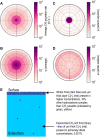Charon's refractory factory
- PMID: 35714189
- PMCID: PMC9205591
- DOI: 10.1126/sciadv.abq5701
Charon's refractory factory
Abstract
We combine novel laboratory experiments and exospheric modeling to reveal that "dynamic" Ly-α photolysis of Plutonian methane generates a photolytic refractory distribution on Charon that increases with latitude, consistent with poleward darkening observed in the New Horizons images. The flux ratio of the condensing methane to the interplanetary medium Ly-α photons, φ, controls the distribution and composition of Charon's photoproducts. Mid-latitude regions are likely to host complex refractories emerging from low-φ photolysis, while high-φ photolysis at the polar zones primarily generate ethane. However, ethane being colorless does not contribute to the reddish polar hue. Solar wind radiolysis of Ly-α-cooked polar frost past spring sunrise may synthesize increasingly complex, redder refractories responsible for the unique albedo on this enigmatic moon.
Figures





References
-
- Reuter D. C., Stern S. A., Scherrer J., Jennings D. E., Baer J. W., Hanley J., Hardaway L., Lunsford A., McMuldroch S., Moore J., Olkin C., Parizek R., Reitsma H., Sabatke D., Spencer J., Stone J., Throop H., Van Cleve J., Weigle G. E., Young L. A., Ralph: A visible/infrared imager for the New Horizons pluto/kuiper belt mission. Space Sci. Rev. 140, 129–154 (2008).
-
- Stern S. A., Bagenal F., Ennico K., Gladstone G. R., Grundy W. M., McKinnon W. B., Moore J. M., Olkin C. B., Spencer J. R., Weaver H. A., Young L. A., Andert T., Andrews J., Banks M., Bauer B., Bauman J., Barnouin O. S., Bedini P., Beisser K., Beyer R. A., Bhaskaran S., Binzel R. P., Birath E., Bird M., Bogan D. J., Bowman A., Bray V. J., Brozovic M., Bryan C., Buckley M. R., Buie M. W., Buratti B. J., Bushman S. S., Calloway A., Carcich B., Cheng A. F., Conard S., Conrad C. A., Cook J. C., Cruikshank D. P., Custodio O. S., Ore C. M. D., Deboy C., Dischner Z. J. B., Dumont P., Earle A. M., Elliott H. A., Ercol J., Ernst C. M., Finley T., Flanigan S. H., Fountain G., Freeze M. J., Greathouse T., Green J. L., Guo Y., Hahn M., Hamilton D. P., Hamilton S. A., Hanley J., Harch A., Hart H. M., Hersman C. B., Hill A., Hill M. E., Hinson D. P., Holdridge M. E., Horanyi M., Howard A. D., Howett C. J. A., Jackman C., Jacobson R. A., Jennings D. E., Kammer J. A., Kang H. K., Kaufmann D. E., Kollmann P., Krimigis S. M., Kusnierkiewicz D., Lauer T. R., Lee J. E., Lindstrom K. L., Linscott I. R., Lisse C. M., Lunsford A. W., Mallder V. A., Martin N., McComas D. J., McNutt R. L., Mehoke D., Mehoke T., Melin E. D., Mutchler M., Nelson D., Nimmo F., Nunez J. I., Ocampo A., Owen W. M., Paetzold M., Page B., Parker A. H., Parker J. W., Pelletier F., Peterson J., Pinkine N., Piquette M., Porter S. B., Protopapa S., Redfern J., Reitsema H. J., Reuter D. C., Roberts J. H., Robbins S. J., Rogers G., Rose D., Runyon K., Retherford K. D., Ryschkewitsch M. G., Schenk P., Schindhelm E., Sepan B., Showalter M. R., Singer K. N., Soluri M., Stanbridge D., Steffl A. J., Strobel D. F., Stryk T., Summers M. E., Szalay J. R., Tapley M., Taylor A., Taylor H., Throop H. B., Tsang C. C. C., Tyler G. L., Umurhan O. M., Verbiscer A. J., Versteeg M. H., Vincent M., Webbert R., Weidner S., Weigle G. E., White O. L., Whittenburg K., Williams B. G., Williams K., Williams S., Woods W. W., Zangari A. M., Zirnstein E., The Pluto system: Initial results from its exploration by New Horizons. Science 350, aad1815 (2015). - PubMed
-
- Grundy W. M., Cruikshank D. P., Gladstone G. R., Howett C. J. A., Lauer T. R., Spencer J. R., Summers M. E., Buie M. W., Earle A. M., Ennico K., Parker J. W., Porter S. B., Singer K. N., Stern S. A., Verbiscer A. J., Beyer R. A., Binzel R. P., Buratti B. J., Cook J. C., Ore C. M. D., Olkin C. B., Parker A. H., Protopapa S., Quirico E., Retherford K. D., Robbins S. J., Schmitt B., Stansberry J. A., Umurhan O. M., Weaver H. A., Young L. A., Zangari A. M., Bray V. J., Cheng A. F., McKinnon W. B., McNutt R. L., Moore J. M., Nimmo F., Reuter D. C., Schenk P. M., The formation of Charon’s red poles from seasonally cold-trapped volatiles. Nature 539, 65–68 (2016). - PubMed
-
- Grundy W. M., Binzel R. P., Buratti B. J., Cook J. C., Cruikshank D. P., Ore C. M. D., Earle A. M., Ennico K., Howett C. J. A., Lunsford A. W., Olkin C. B., Parker A. H., Philippe S., Protopapa S., Quirico E., Reuter D. C., Schmitt B., Singer K. N., Verbiscer A. J., Beyer R. A., Buie M. W., Cheng A. F., Jennings D. E., Linscott I. R., Parker J. W., Schenk P. M., Spencer J. R., Stansberry J. A., Stern S. A., Throop H. B., Tsang C. C. C., Weaver H. A. II, Weigle G. E., Young L. A.; and the N. H. S. Team , Surface compositions across Pluto and Charon. Science 351, aad9189 (2016). - PubMed
LinkOut - more resources
Full Text Sources
Miscellaneous

